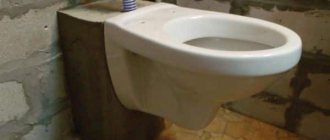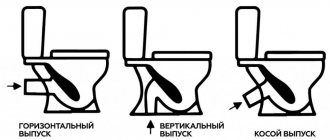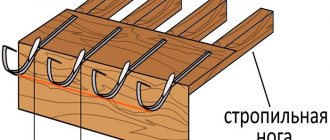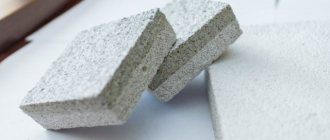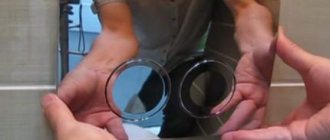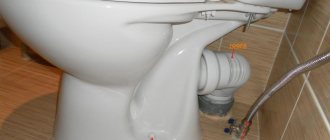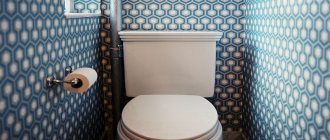Why choose a wall-hung toilet
When making renovations in a bathroom or toilet, the consumer is necessarily faced with the question of choosing the type of toilet: a wall-hung toilet
or
a traditional floor-mounted toilet with a cistern
. Thanks to our mentality, we like to stick to time-tested classics and often reject innovation and modern trends. Moreover, wall-hung toilets in the post-Soviet space still do not account for even half of total toilet sales. Please note the following fact: according to various estimates, from 80% to 90% of toilet sales in the European Union are wall-hung toilets. And this indicates a significant lag and indicates the path to catching up the existing difference. In the meantime, the numbers speak for themselves and there are certain reasons for this.
All the benefits of wall-hung toilets can be defined quite briefly:
- • space saving,
- • hygiene,
- • noise reduction,
- • easy to clean.
However, the purpose of this review is not to determine the benefits of wall-hung toilets. We want to give an extended answer to the question: what is important to pay attention to when choosing an installation for a wall-hung toilet when purchasing
.
Choice by price/quality ratio
So, the design of a wall-hung toilet itself is impossible without the use of an installation for a wall-hung toilet
, because is an integral part of the wall-hung toilet.
First of all, we would like to draw your attention to the difference in the approach to choosing between a toilet and an installation. A wall-hung toilet is a ceramic product and to select it, it is important to pay attention to the quality of enamel, clay, shape geometry, design and color. And the installation for a wall-hung toilet is primarily a mechanical product with moving parts
from steel, plastic, rubber, up to brass and bronze parts.
This is a mechanism that is subject to external influences. Consequently, here the criteria of quality and durability become more relevant
. This is where you need to pay attention to the difference in cost between models and understand what you need to pay for and how to qualitatively choose the option you need.
The principle “cheap cannot be good” when purchasing an installation is more relevant than ever.
— Tip #1
Design Features
Having seen a wall-hung toilet, a rare visitor to a plumbing store will not be puzzled by the question: how does the structure hold up, what ensures its strength? After all, the toilet bowl does not have the usual foot. Fastenings that guarantee reliability are also not visible on the surface.
Wall-hung toilet
The installation provides stability - a massive steel frame, which is often sold separately from the toilet. It can be attached only to the wall or additionally to the floor. It is covered with a plasterboard false wall on top, and the illusion is created that the plumbing fixture is really not supported by anything.
Since the cistern, along with all communications, is hidden behind plasterboard, most often the structure is located in the niche of the bathroom, where the water supply and pipes are located. If you choose another location, keep in mind that you will still need to make a 20-25 cm recess in the wall to accommodate the tank. It has 4 mounting points, 2 of them on the floor, which allows you to set the desired height. The tank itself is made of plastic, not ceramic, like a regular one. It can be accessed through a panel with a button located above the bowl. Through it you can turn off the water or make minor repairs.
Installation of several installations in the bathroom
The bowl of such a toilet is the only thing that is visible from the entire structure, so its selection must be approached especially carefully. Design developments allow you to choose:
- color - from classic white to acidic or rainbow shades;
- shape - from round and oval to rectangular and other, more complex modifications;
- materials - from ceramics and steel to plastic, polymer concrete and glass.
Advice. From a practical point of view, plastic is not very convenient: it scratches easily. Polymer concrete does not accept cleaning with all means. When choosing between earthenware and porcelain, give preference to the latter. Thanks to its smoother surface, it needs to be cleaned much less often.
What you should pay attention to when choosing an installation
What weight can the installation bear?
When you decide to buy an installation for a wall-hung toilet, you may immediately wonder whether such a structure can withstand the weight of the toilet itself along with a person.
Specialized European manufacturers produce modern installations that can withstand up to 400 kg of load
.
— Tip #2
Wall hung toilet installations have become widespread since the 1960s and technology is evolving every day. By distributing the load from the toilet to a person, the main part of the load is distributed to the installation supports located on the floor. European manufacturers even organized special marketing events at the stage of popularizing wall-hung toilets. A car was installed on the installation with wall-hung toilets, elephants were planted (these old advertising campaigns can be found on YouTube), so that the consumer could buy an installation with a wall-hung toilet with peace of mind and not worry about the reliability of the design.
Please note that the main load on the installation falls on the lower supports, and the installation itself is attached to the wall.
A prerequisite is a wall thickness of at least half a brick or another wall material equivalent to the strength of a 1/2 brick wall.
— Tip #3
How to access the internal parts of the mechanism after installation
Another fear that a buyer of an installation may have concerns access to the insides of the tank mechanism itself. Will you have to break into the wall if a stone somehow gets into the water pipe?
The dimensions and design of the internal installation mechanisms are specially designed for easy access.
— Tip #4
The answer is very simple - modern manufacturers have thought of everything in such a way that access to the heart of the installation - the tank - is easy - through the hole in the flush key
. All internal parts (drain mechanism, filling mechanism, valves) are specially designed so that they can always be accessed and replaced if necessary.
Internal structure of the Viega Prevista drain barrel
Video with an example of installing the Viega Visign for More button
What is important in the installation body
In a high-quality installation, you will always receive a steel frame, automatically coated with paint that can resist corrosion. After all, the installation for a wall-hung toilet will be installed behind a wall and will be hidden from your eyes for at least 20 years.
How much weight can the toilet support? Is it possible to stand on the toilet (small work on the ceiling above the toilet)?
Is it necessary to locally repair the ceiling above the toilet? How much weight can the toilet support and is it possible to stand on it?
Toilets (floor compact) are manufactured strictly in accordance with GOST.
In the technical characteristics of the toilet there is also such an indicator (parameter) as the maximum possible load on the toilet.
If we are talking about a floor-standing toilet, then this is 200 kg and no more.
This is quite enough, because the operating conditions of the toilet do not allow the full weight of a person to load it, feet on the floor, in other words.
But it is important to consider that there may be microcracks in the toilet that are not visible during visual inspection, but there are no leaks.
From personal experience I can add, I changed the customer’s toilet at my own expense, the reason was the same microcrack, I stood on the toilet, it “scattered” under me, my weight was 100 kg (+-), that is, the load was 2 times less than the permissible one.
I don’t recommend standing on the toilet; in addition to microcracks, there is a load of a different effect, of a different direction.
If you really need to, then cut a piece of thick plywood, or MDF, chipboard, slightly larger than the size of the toilet bowl, open the lid (you absolutely cannot stand on it) and lay down the plywood.
In this case, the load will be uniform and not point-like on the edges of the toilet.
It’s even better to look for other options, the toilet may not crack (bowl), the platform in the area of the fastening bolts will crack due to lateral load
Especially if the bolts are not properly tightened and there is play, or you “forgot” to install plastic bushings between the bolts and the toilet
The shaft of the metal bolt is in contact with the earthenware and this is a “dangerous” contact.
A construction stepladder stands quite normally above the toilet, with its legs on the sides resting on the floor. If you have one, then it is certainly better not to expose the toilet itself to such influences.
Floor-standing toilets must withstand a breaking pressure of at least 300 kilograms . Wall-hung toilets can withstand at least 150 kilograms , although their installation can withstand up to 400 kilograms , because some frame installations are made very massively.
If there is no other way out, you can stand on the toilet without swinging on it and distributing the pressure as evenly as possible along the entire perimeter. It goes without saying that you should not stand on the stationary plastic toilet lid, which is designed to simply cover the sink and protect it from odors and foreign objects. You should use a wide wooden surface (metal can scratch the enamel). You can put a piece of unplaned board 40-50 millimeters thick and at least 200 millimeters wide. On the bottom side of the board, nail blocks along the width of the toilet, and on the inside so that the board does not “crawl” on the sink. When performing work on such a stand, you should exercise maximum caution and attentiveness, because adapted stands always have a risk of injury. A small table that can support your weight, placed on top of the toilet and resting on the floor, will be more reliable than standing on the toilet itself.
What to look for when choosing an installation tank
When choosing an installation, also pay attention to the tank body.
In higher-quality installations, the tank is made of plastic and is solid, and also lined with foam plastic.
— Tip #5
In cheaper versions, the plastic tank is a vessel welded in two parts. This is less reliable compared to a one-piece tank.
Also in a high-quality installation you will find a tank lined with foam plastic. This is not made for transportation - do not tear off this foam under any circumstances.
It performs 2 important functions:
- 1) reduces the noise level when filling the tank with water;
- 2) protects the tank from condensation due to temperature differences.
Typically, the difference in temperature between cold water and the space around the installation is more than 10 degrees Celsius. And this can cause corrosion or create conditions for the development of microorganisms and fungi.
Photo of the tank from the installation
Viega Prevista Dry 792862
The price of hanging plumbing is higher
It is generally accepted that floating analogues are more expensive than toilets on a support. This is often true, but it depends on what you compare. If you contrast an imported installation with a low-cost budget model of a traditional toilet, the latter will be cheaper, but if you compare models in the same segment and from similar manufacturers, the wall-hung option may turn out to be even more affordable.
What will really cost more is the installation of a suspended model. Especially when it comes to renovating secondary housing.
If the installation replaces a floor structure, the sewer wiring will need to be redone.
Pay attention to the installation fittings
Another factor to consider when deciding on the choice of installation is the material from which the fittings and other connecting elements are made.
High-quality and durable fittings will contain brass or bronze, while cheap analogues will contain stainless steel and other cheaper materials (even powder steel).
— Tip #6
And this will definitely affect the trouble-free life of the installation and wall-hung toilet.
Photo of the fitting for the installation
Viega Prevista Dry 771980
Photo of the installation for the
Schell Montus C120
The installation system will withstand everyone. Answered by Geberit
Often, a buyer, faced with the need to purchase high-quality engineering plumbing, has the feeling that he does not have enough information: what factors to be guided by, who to turn to, what parameters to make a decision on, who to trust. Among other retail chains in the city of St. Petersburg, ELSO EnergoDom stores stand out due to their location (today there are 10 retail outlets in different areas of the city), the qualifications of the staff, and the assortment presented. Among the numerous items presented in ELSO EnergoDom stores, the products of the Swiss company Geberit deserve special attention. At the exhibition, the buyer will always find comprehensive information about the products of this factory, appreciate a worthy selection, a detailed presentation of the products of this brand, the versatility and effectiveness of the solutions offered, as well as the competence of the sales staff in this product group - concealed-mounted plumbing systems.
How to choose a flush button
Another mechanism that is present in the installation is the flush key, which directly activates the flush mechanism. Traditionally, the flush button has 2 keys for a large and a small flush, which allow you to rationally address the issue of water consumption.
Speaking of mechanisms, all time-tested installations from the best manufacturers use a mechanical drive for the flush valve.
— Tip #7
There were attempts to use an alternative drive - pneumatic, but this was just a marketing ploy to advertise an alternative sensation when pressing a key. As a result, in operation the mechanics proved to be an unreliable mechanism.
It is also worth noting that the flush button is the face of the installation, the part that is always visible. From reputable manufacturers you can always find a wide variety of different materials (plastic, glass, metal) and appearance. The right flush design will become an elegant element in the overall bathroom concept.
Manufacturers of quality products usually offer 2 options for choosing a flush button: it is proposed to buy a separate installation and a separate button (choosing the design you like) or buy a ready-made installation kit that includes the most popular and universal flush buttons. Such options are traditionally offered in two colors - white and chrome. Moreover, the color chrome usually accounts for about 90% of sales. Chrome almost always fits universally into a bathroom concept.
Often, customers, studying the buttons in our showrooms, pay attention to traces of fingerprints remaining on the chrome surface and conclude that this will happen even after installation in the bathroom. It's a delusion. Flush buttons presented in showrooms are touched daily in places that are not used during operation. In life, everything happens differently. During operation, only the moving parts of the flush buttons come into contact with your fingers and, therefore, fingerprints cease to be a problem.
The variety of installation flush buttons is also complemented by anti-vandal solutions or touch keys
, which prevent contact with the surface of the flush button. But these solutions are more often used in public places. An example of such a solution is the flush key below.
Photo of flush panel with IR activation
Viega Visign for Public 12
New! Flush button that is installed flush with the tiles. This option goes well with ceramic tiles.
— Tip #8
An interesting innovation in the field of flush buttons in recent years is the appearance of special frames,
which allow you
to install the flush button flush with the tiles
. This way the flush button will be in the same plane as the tile and will not “stick out”. This creates an interesting and unique design and is popular with people who appreciate modern design ideas.
You can find out more about such buttons in our review.
Viega Visign for More 104 flush button
Price
One of the main issues is the renovation budget . And here everything is quite clear: a wall-hung toilet will obviously cost more than a floor-standing one. The price of a wall-hung toilet bowl is approximately the same as that of a similar floor-standing model, or a little more expensive. But you will also have to buy an installation system.
You can choose a kit that includes everything you need, it will cost about 20-30 thousand rubles. But if special design requirements arise, the price rises. For example, it is often necessary to select an installation of a non-standard size in order to save space.
The cost can also increase due to flush buttons. The installation kit includes a standard version. But in design projects they are often replaced with more aesthetically pleasing ones that fit the overall interior of the room. These buttons can be of different colors and made of different materials: glass, plastic, metal.
NB! The buttons also differ in their pressing system. The standard option is mechanical. Behind the button is a lever that presses the valve. Another option is pneumatic, with an air tube. They are chosen if the button is located not as usual, behind the back, but on the side.
Another cost item is installation. Installing a floor-standing toilet is quite easy; you can do it yourself or invite any plumber. But with the suspended version the situation is much more complicated. It is necessary to correctly install the installation at the stage of rough repairs, then sew the installation into a box, and finally install the bowl and flush buttons.
These jobs are much more complex and it is important to do them correctly. Manufacturers claim that most breakdowns are not due to shortcomings of the models, but to installation errors. It is not recommended to do the installation of hanging systems yourself; it is better to invite experienced specialists. This means costs are rising.
The box is usually lined with porcelain stoneware. Those tiles that are located immediately behind the toilet bear a large load. Porcelain stoneware from 8, or better yet, 12 mm in thickness is suitable. We add to the estimate the costs of materials and tiler services.
If you add up all the costs, a wall-hung toilet will cost significantly more than a floor-standing one. And all questions of choice usually come down to one thing - is it worth it to overpay for a wall-hung toilet? Let's see what advantages hanging models have.
Adjusting the installation height of a wall-hung toilet
Traditionally, installation kits are height adjustable only through the supports. It is worth noting that the European standard for the installation height of a wall-hung toilet from the floor is 43 cm
(similar to conventional floor-standing toilets with a cistern). This installation height can be achieved with any high-quality European installation. The supports themselves are usually made of either steel or plastic.
Installation supports made of steel or plastic break during installation due to inexperience or excessive force of the installer.
— Tip #9
Both materials are reliable in terms of operation. But there is a problem with plastic supports in the domestic market. Plumbers who began their careers back in the USSR, due to inexperience, apply excessive force during installation and break the plastic fasteners.
Retro toilet with high flush tank
|
|
In Soviet times, a standard toilet was equipped with a flush cistern mounted on the wall, at a height of 0.6 - 1.3 m from the lid of the device. Later they were abandoned in favor of compacts, where the tank is attached directly to the toilet bowl. Currently, this configuration is used for interiors in retro and classic styles.
Vintage toilets are attached to the floor, and the upper flush cistern is fixed with dowels on the wall or installation. The disadvantages of this design are:
- small resource of metal flush pipes between the tank and the bowl;
- low decorative value of polymer flush pipes;
- complex installation of a plumbing inspection hatch;
- increase in labor intensity, material consumption, installation cost;
- difficult access to the tank, maintenance of flush fittings.
The advantages include the following factors:
- possibility of decorating retro interiors;
- guaranteed powerful drain due to height difference;
- reducing the size of the toilet bowl.
Floor-standing, corner and attached models of plumbing fixtures can be equipped with an upper tank. When making boxes and false panels, it is necessary to place jumpers or racks into the frame for attaching the tank.
Compatibility of installation and wall-hung toilet
When buying an installation for a wall-hung toilet, you will definitely ask about compatibility when installing a wall-hung toilet on it. Rest assured, there is only one important parameter - the center distance between the toilet mounts.
There are only 2 standards: 18 and 23 cm
for center distance.
At the same time, the size 18 cm occupies 97% of the market in the CIS countries. — Tip #10
Any more or less high-quality installation for a wall-hung toilet is standardly prepared for installing a toilet with an interaxial distance of 18 and 23 cm. Therefore, there is no need to worry about this issue.
Wealth of choice
Oval, round, rectangular - whatever shapes designers can come up with for wall-hung toilets. In order to roughly imagine the variety of models, you need to multiply the number of shapes by the number of colors and shades, but there are also toilets with drawings. In addition, toilets are available in different sizes, there are even small children's models.
Or another direction for expanding the range - high-tech new items. A toilet with a built-in bidet is already a thing of the past. Nowadays there are often models with built-in thermometers and clocks. And for wealthy clients, special computer programs will indicate the presence of protein in the urine or something else like that.
Why is a rimless toilet better?
Speaking about compatibility in the operation of the installation, it is impossible not to touch upon the topic of rim and rimless wall-hung toilets. This topic deserves a separate review.
Rimless wall hung toilets have a modified bowl in the area of the traditional rim,
they do not have it, and the surface
is completely enameled
. But in rimless toilets, the surface of the rim is not enameled.
Rimless toilets make cleaning easier, improve hygiene and reduce water consumption by changing the flow of water when flushing.
— Tip #11
The flow, due to greater intensity, accelerates and results in less water consumption. This was the main prerequisite for the invention of rimless toilets. Since 2012, ceramic manufacturers began to introduce their production. As of March 2021, almost all European ceramic manufacturers offer rimless wall-hung toilets, and some top brands have already discontinued regular rimless toilets.
The key point in the compatibility of the installation and the toilet is the correct regulation of the water flow.
— Tip #12
Often, after installing the installation and wall-hung rimless toilet, the consumer is faced with the problem that when flushing, water splashes out of the toilet onto the floor.
This problem is precisely caused by a change in the direction of water flow in a rimless toilet, and the intensity of the flow of water released plays a key role here. This problem is compounded by the variety of shapes and design options for wall-hung rimless toilets. Consequently, installation settings to regulate flush volume and water flow rate, which were standard 10 years ago, can lead to water splashing out onto the floor.
There are solutions to this problem! Some manufacturers sell additional accessories - adjusting rings or a flush speed reducer.
A flush speed reducer or adjusting rings allow, by narrowing the drain manifold, to reduce the flow rate of water supplied from the installation.
— Tip #13
Therefore, when purchasing an installation and a rimless toilet, you should clarify in advance whether the installation is equipped with a flush flow rate regulator.
In the photo (on the right) flush speed reducer
Viega Prevista 78636
Video of water adjustment in the Viega Prevista installation
Adjusting the flush in
Tece installations
Speaking of saving water, almost all manufacturers of installations provide the possibility of large and small flushes, implemented by two keys on the flush panel. Also, the best manufacturers provide regulation of the volume of water used for large and small flushes.
The standard settings are 4.5/9 liters small/large flush. When using a wall-hung rimless toilet, it is considered sufficient to reduce the standard flush volume by 2 times, i.e. 2.5/4.5 liters.
— Tip #14
What does the installation consist of?
The structure, which takes on the weight of the suspended bowl along with the person sitting on it, and also serves to communicate the supplied water fittings, must be strong, rigid and firmly attached to the wall or floor. In essence, the installation consists of steel elements of a certain cross-section, forming an almost monolithic spatial solution.
Almost all modern plumbing fixtures for the toilet are equipped with a double flush function: this helps to use water efficiently.
And the installation for an attached toilet is a kind of adapter in which a tank with a flush system, a sewer outlet and fittings for water supply are mounted. The solution is completely ready for installation, so no additional configuration or selection is required. That is why the type of fastening is clearly tied to a specific type of toilet
And it is important to take into account all the necessary nuances in advance in order to avoid possible mistakes.
What to do if you need a non-standard installation
When choosing installations, you can see special models that can be used in non-standard conditions:
- • Installations for installation in a corner;
- • Low installations with a height of 82 cm (standard height 113 cm).
Models are specially developed for applications where conventional installation is not possible. For example, in low installations there are options for installing a flush button either traditionally from the front or from above
, above the installation plane.
It should be noted that the minimum installation thickness is 12-13 cm, but there are special modifications with a thickness of 8 cm
, which allow you to save precious centimeters in small spaces.
There are also free-standing installations and installations for installation in artificial partitions
.
One important fact should be noted: all non-standard installation options for wall-hung toilets are much more expensive than traditional ones
and the most popular models, which is explained by a significant difference in the production run, and this greatly affects the cost of the final product.
Example of low installation implementation
Myth No. 6. Installations “steal” a lot of space
Consumers who are not inclined to understand the nuances sometimes believe that after installing the mounting elements for the toilet and sink, a significant part of the toilet or bathroom will have to be sacrificed due to the installation of a plasterboard false wall.
But let's do the math. The depth of the cistern of a floor-standing toilet is usually at least 18-20 cm, and that of a built-in toilet with a frame is no more than 10-11 cm. Thus, the wall-hung model will stand 10 cm closer to the main wall than its classic counterpart. The gain in free space, as they say, is obvious! In addition, the false wall helps to hide all pipes and communications that should not be visible, and the installation for a wall-hung toilet or bidet.
Additional functions of the installation
Another option associated with the flush button is a special magnetic frame for the flush button, where a container for water disinfectant tablets is located
. Due to the magnetic design, access to the container through the button will be quite easy, and the disinfectant tablets themselves will increase the hygiene of the bathroom and freshen the air.
The photo shows
a frame for tablets Viega 773366
Frame for Viega disinfectant tablets
One of the interesting marketing moves of installation manufacturers is the function of exhaust ventilation through the flush hole
.
Manufacturers implement this functionality in different ways - one option is to add an exhaust fan, controller and carbon filter to the installation
.
Operating principle: the air passed through the filter is returned back to the room. Another manufacturer may have a different implementation - the flush elbow of the installation is supplemented with a special outlet pipe, which can be connected to the general ventilation system
. This solution is much cheaper, but requires an additional connection to the general ventilation system. This air purification function is found in modern shower lids and shower toilets, where it and a special filter are included as standard.
The photo shows the flush elbow Viega 786 342
Video example of installation of Schell Montus installation
Pros and cons
Among the undoubted advantages of these plumbing models it is worth noting:
Corner installation
- Compactness. Due to the fact that everything unnecessary is hidden in the wall, the toilet looks very neat.
- Ease of cleaning. This hygiene item is much faster to clean and easier to clean the floors in the room.
- Less noise during draining. Since the tank is located behind the wall, water is drawn into it more quietly than usual.
- Possibility to configure full or half drainage.
- Reliability.
The negative aspects of use include the following:
- For installation, you need to invite a specialist, although there are reviews about installing the structure yourself. However, if you don’t want to risk stability and reliability, it’s better to play it safe and call a professional.
- Sometimes, in order to install a suspended model, you need to change and move sewer and water pipes, and this is an additional expense.
Installation - If there is no niche in which to build a tank, you need to make a recess in the wall, which is not always convenient.
- The installation cannot be installed near partition walls; it must be permanently fixed.
- In some situations, when free access to common communications is needed, a false plasterboard wall prevents this.
Let's sum it up
Please take into account the fact that the installation of the toilet bowl and flush key occurs only after tiling. Installation of the installation is a rough job and always occurs at the beginning of the renovation. Therefore, it is advisable to immediately know which model of wall-hung toilet will be installed on the installation
.
But by choosing a high-quality European manufacturer, you will gain confidence in the technical compatibility of the products and fine-tuning the operation of the installation units and wall-hung toilet
.
Based on the experience of retail sales of the Von Tann
, experience as a wholesale supplier to hotels, multifunctional centers, public places, we recommend such brands as reliable, high-quality, specialized manufacturers of installations:
Viega (Germany), Geberit (Switzerland), Tece (Germany-Poland), Schell ( Germany)
. Each of them has service centers in the Republic of Belarus.
The review is based on the example of
Viega
What sizes are toilets?
Standard toilet sizes are designed for people of average height and build. Not everyone is like that. And a toilet with a shelf, which is described in GOST, is far from the best choice in terms of aromas. Also, most of the products in stores today are imported.
And they have their own standards. For example, the European standard toilet size is 680*360*400 mm (this is the length, width at the widest part and the last number is the height).
The Americans went even further - their usual “depth” is 768 mm, width 380 mm, the height of the rim above the floor is still the same - 36-38 cm. As you can see, the standards are different, and not everything is made according to the standards. People have different needs and the market is trying to satisfy them.
Dimensions of floor models
As you understand, floor-standing toilet models are different and their sizes are also different. We will give a range, but we do not guarantee that there are no narrower or wider ones. Most likely, if you set a goal, you can find both.
Compact
The Compact type toilet (with a tank attached to the back) has the following dimensions:
- length - 610-645 mm;
- width from 345 mm to 420 mm;
- height from 370 mm to 395 mm.
Note that the narrowest bowls are more like a rectangle. They are not as round as we are used to
They are quite convenient to use. There may just be problems when buying a cover. This form is rare.
Without tank
A toilet without a shelf with a wall-mounted or separate tank has the following dimensions:
- length 435-460 mm (20 cm less than Compact models!);
- width 360-400 mm;
- rim height from floor level 350-390 m.
As you can see, they are more compact, despite the name given to the previous version. But such models are less popular, since the tank must be secured, and this is an additional headache.
Previously, this type was considered a “relic”; now it is stylish and interesting. There are very interesting models (though they have interesting prices).
Monoblock
There are also Monoblock floor-standing toilets. They are mostly wall-mounted. These are those in which the tank and bowl are one-piece and one is a continuation of the other. The dimensions of Monoblock toilets are:
- length - 665-720 mm;
- width (usually the tank is wider, but not always) - 360-420 mm;
- height:
- from the floor to the top of the lid - 700-870 mm;
- from the floor to the rim of the bowl - 360-390 mm.
These models cannot be called small. Perhaps that is why they are not very popular among us. Whatever one may say, it is easier to carry the bowl and tank separately than the entire assembled structure. But the probability of leakage is less.
Dimensions of hanging models
For wall-hung toilets, you need to look at the dimensions of the bowl itself and the installation. They usually come included. And, as a rule, more questions arise with installation.
Actually, the size of the installation depends on the planned load. External unreliability and fragility are deceptive. A wall-hung toilet with a reinforced frame can withstand weight up to 400 kg, standard designs - up to 200 kg, and super strong ones - up to 400 kg.
The dimensions of installations for wall-hung toilets are as follows:
- height - 1100-1250 mm;
- width 400-550 mm;
- depth - 140-250 mm.
These are average values. There are also narrow installations - they can be from 345 mm. True, their “loading capacity” is about 120-150 kg. And those that are found are most often about 50 cm wide. As you can see, they do not take up too much space.
Now about the bowl sizes of wall-hung toilets. It has the following dimensions:
- length 480-560 mm;
- width 356-430 mm.
The height of the wall-hung toilet bowl may vary. Depends on the style. There are almost flat bowls, 290-320 mm high, and there are medium ones - 340-365 mm. Moreover, they have a very different appearance: square, round, oval, tapered towards the bottom or rounded, more like a washer.
The height will be “selected” automatically. It will depend on the dimensions of the bowl and the location of the hole for the sewer outlet in the installation. You will only need to make sure that they are compatible (the same size and that the bottom of the bowl does not “lie” on the floor).
PS
And one more piece of advice: often plumbers, without even asking clients, independently choose the installation to install based on their own interests. It’s good when a plumber installs high-quality installations. But very often the opposite happens.
More about the kits
As you can see, there are quite a lot of nuances in choosing high-quality and durable plumbing fixtures. Therefore, regarding the selection and correct choice of plumbing products, we recommend contacting our Von Tann salons.
. Here you can get professional advice, see toilet installations in action, touch, feel and make an informed and correct choice.
Minsk, Dzerzhinsky Ave., 9
+375 (29) 372-20-05, +375 (17) 394-99-49
Minsk, Pobediteley Ave., 65 in the shopping center Castle HOME, pav. 420
+375 (17) 224-24-80, +375 (29) 676-73-78
Gomel, Lenin Ave., 14
+375 (23) 231-99-06, +375 (29) 696-90-85
Popular manufacturers and prices
The cost of toilets directly depends on the country of origin. This includes not only the cost of raw materials and labor, but also customs duties, transportation costs, and the system for calculating and refunding VAT on imports and exports.
The cheapest, budget toilets are produced in Russia and China. They account for 80% of the produced volume of plumbing fixtures in the lower price segment. Judging by the demand, the product quality is comparable to the price, which suits the consumer.
The most famous brands are Huida (China), Sanita and Santek (Russia). In the middle price segment, mainly Finnish, Polish, Czech, Spanish and Turkish companies operate. The cost of their plumbing is in the range of 9.0-17.0 thousand rubles. The most famous brands are Ido (Finland), Cersanit, Kolo (Poland), Jika (Czech Republic), VitrA (Turkey).
The most expensive products are from German, Austrian, Swedish and, partly, Turkish toilets. Here prices start from 300 US dollars and end in several thousand dollars. But this is the case when you have to pay the right price for good quality and great design.
The most famous companies are Gerebit, Villeroy & Boch (Germany), Svedbergs, Gustavsberg (Sweden), and VitrA (Turkey).
Installation is a high-quality and convenient option for plumbing products for the toilet. A well-chosen model will last a long time, and most importantly, it will transform the room beyond recognition.
Choosing a flush cistern
All manufacturers make the flush tank from plastic; it can consist of one or two parts (one-piece or prefabricated). Inside it there are plumbing fittings that provide automatic filling and flushing. You shouldn’t pay much attention to its appearance: it will still be hidden from view.
Product quality and functionality are important:
In our installations, the tank is made of a single piece of polyethylene; it cannot be broken even with a sledgehammer. There are no metal parts inside the tank that come into contact with water, and this guarantees the absence of corrosion.
The drain tank often becomes a subject of concern for people who dream of installing an installation, but are afraid of leaks. As our expert says, they are afraid in vain.
Our tanks have no seams, and the drain mechanisms are equipped with an emergency overflow with a siphon effect. It drains water into the sewer even at maximum operating water pressure before filling.
There are models of installations without a tank - the water for flushing comes directly from the pipes. The depth of such installations is less, but flushing will always depend on the water pressure in the water supply system. And at the same time, pressure fluctuations in the cold water supply system can cause discomfort and even burns if someone is using a shower.
